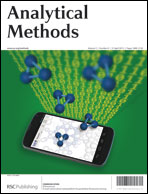Simultaneous determination of methamphetamine and ketamine in human hair using ultrasonication and LC-ESI-MS/MS method
Abstract
A rapid and reliable method for simultaneous determination of methamphetamine (MAM) and ketamine (KET) in human hair was developed. MAM and KET in hair samples were collected using ultrasonication with methanol/5 M hydrochloric acid (HCl) for 1 hour, and detected by liquid chromatography-tandem mass spectrometry (LC-MS/MS). In this experiment, drug-free human hairs were added into standard solution and kept for 16 hours in order to minimize the difference between blank spiked samples and authentic samples. D8-MAM as internal standard, the linear ranges of MAM and KET were 1–100 pg mg−1 and 2–200 pg mg−1 with correlation coefficients greater than 0.999, respectively. The limit of detection (S/N ≥ 3) was 0.03 pg mg−1 for MAM and 0.06 pg mg−1 for KET, the limit of quantification was (S/N ≥ 10) 0.09 pg mg−1 for MAM and 0.21 pg mg−1 for KET. Accuracy evaluated by recovery spiked at three different concentrations, was in the ranges of 91–114% for MAM and 88–119% for KET. The intra- and inter-day standard deviations of all analysis results were less than 3.50%. This method was applied to analyze residue levels of MAM and KET in human hair samples.


 Please wait while we load your content...
Please wait while we load your content...